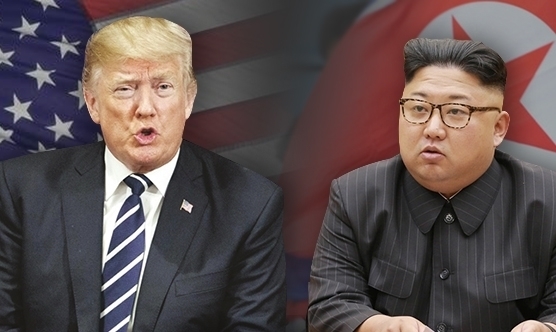 |
|
US President Donald Trump and North Korean leader Kim Jong-un
|
Moon stresses that US has “nothing to lose” by loosening sanctions
US President Donald Trump officially signaled plans on Sept. 24 for a second summit with North Korean leader Kim Jong-un, which he said would be taking place “in the not too distant future” at a time and place to be announced shortly. The second set of denuclearization talks between the two leaders now appears almost certain to take place as early as October, and no later than the end of the year. One shortcut to allowing them to sit down together quickly would be to narrow their differences on North Korea’s initial denuclearization measures and corresponding actions from the US. With Kim having already expressed his strong commitment to denuclearization to Trump by way of South Korean President Moon Jae-in – and even his intent to dismantle the North’s nuclear facilities at Yongbyon – the corresponding actions from the US appear likely to be the key question. “The question now hinges on how quickly the US can take corresponding action if North Korea adopts some measure of sincere denuclearization measures,” Moon said in a Sept. 25 interview with Fox News. “If the US does adopt swift corresponding measures, then we’ll be able to generate more speed with North Korea’s denuclearization measures,” he suggested. He went to stress that “corresponding measures do not mean simply loosening sanctions.” “We could have a declaration ending the [Korean] war first, we could consider humanitarian aid, and we could have non-political forms of exchange like performer groups,” he said. Other possibilities he said could be considered included “establishing a liaison office in Pyongyang for the US’s long-term observation if [North Korea] dismantles its Yongbyon nuclear complex” and “exchanging economic observation teams to give a preview of the bright future that awaits North Korea once denuclearization measures are complete.” Noting that corresponding measures such as the suspension of military exercises, an end-of-war declaration, and the loosening of sanctions could be reversed at any time, Moon stressed that the US “has absolutely nothing to lose.” Corresponding measures should happen in parallel in the broader scheme of things Regarding measures by North Korea and the US, he said, “We can’t demand that they take place simultaneously, but I do think they should happen in parallel in the broader scheme of things.” The same vision appears likely to have been shared with Washington by Moon himself or through working-level channels. Washington has recently avoided publicly broaching the topic of an end-of-war declaration, which is seen as the top-ranked example of a corresponding measure. But the White House reportedly voiced its agreement with the argument that a declaration would be a political statement without implications of a withdrawal of US Forces in Korea or weakening of the South Korea-US alliance. “The climate is one where the US could participate in an end-of-war declaration if North Korea takes even some small steps on denuclearization,” a diplomatic source in Washington reported. At the same time, the US remains adamant about sanctions. In a Sept. 25 speech before the UN General Assembly, Trump said the sanctions “will stay in place until denuclearization occurs.” While the North Korean and US leaders appeared strongly committed to the general goal of a second summit, the actual success of the summit – and the likelihood of them happening at all – appears to hinge on discussions at the working level. Both sides will need to coordinate their concessions directly and in explicit terms. Progress appears likely to be made in the discussions if US Secretary of State Mike Pompeo and North Korean Foreign Minister Ri Yong-ho meet during the UN General Assembly session. The US has also proposed talks in Vienna between State Department special representative for North Korea policy Stephen Biegun and his North Korean counterpart. If the two sides can reach a satisfactory deal, a second summit could take place ahead of the US midterm elections on Nov. 6. But preparation times and other considerations suggest it may have to wait until after the elections. In his Sept. 24 remarks, Trump stressed that the US was “in no rush.” Possibility of ending Korean War during 2nd NK-US summit Based on the Moon and Trump’s “deep discussions on the time and venue for an end-of-war declaration and second US-North Korea summit,” a Blue House official predicted on Sept. 24 that the two events could take place at the same time – a situation that would involve coordinating with Kim’s previously announced plans to visit Seoul before the end of the year. In this case, possible candidate sites include such highly symbolic venues as Panmunjom or Pyongyang. Holding the summit in Washington would have a strong effect as an event, but poses difficulties in terms of security, protocol, transportation, and US public opinion. The possibility of a third country cannot be ruled out either. In his remarks, Trump said the summit would “be similar to the format we had before [for the first summit in Singapore], most likely a different location.” Possible candidates include Geneva, where the two sides previously reached their Agreed Framework in 1994, or Vienna, which the US proposed as a venue for working-level negotiations. By Hwang Joon-bum, Washington correspondent Please direct comments or questions to [english@hani.co.kr]






